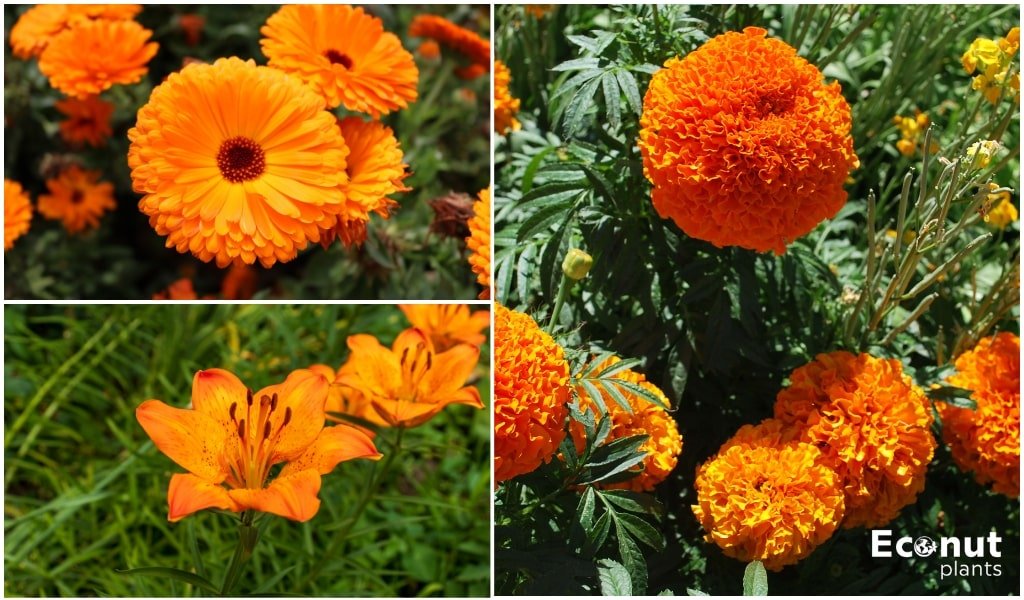Are you thinking about adding beautiful orange flowers to your garden, but you’re not sure which ones to choose? The good news is that there appears to be an endless supply of lovely orange flowers that you may include in your garden.
Orange may make your landscape more cheerful and vibrant. This colour is great for both fall and spring flowers, and it will make you happy all year long.
Read more options for adding some brightness to your outdoor area by scrolling through the list below.
1. Hawkweed
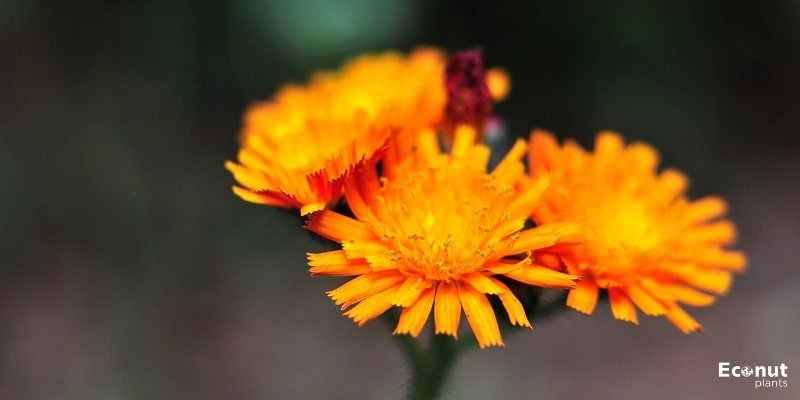
Scientific Name: Hieracium aurantiacum
Plant Type: Perennial
Plant Size: 8 – 35 inches tall
Sun Exposure: Partial to full shade
The beautiful orange flower named hawkweed is indigenous to both Europe and Asia. Hieracium aurantiacum is its scientific name, and it belongs to the Asteraceae family. Hawkweed enjoys full sun to partial shade and thrives in fields, meadows, and the edges of forests.
This perennial flower can grow up to two feet tall and blooms from June to August. The several orange flower varieties of the hawkweed are pollinated by bees and other insects.
Hawkweed is sometimes used as a decorative plant in gardens because of its stunning colours. The Old English word havoc, which means “hawk,” is the source of the name of this flower.
2. Superbells
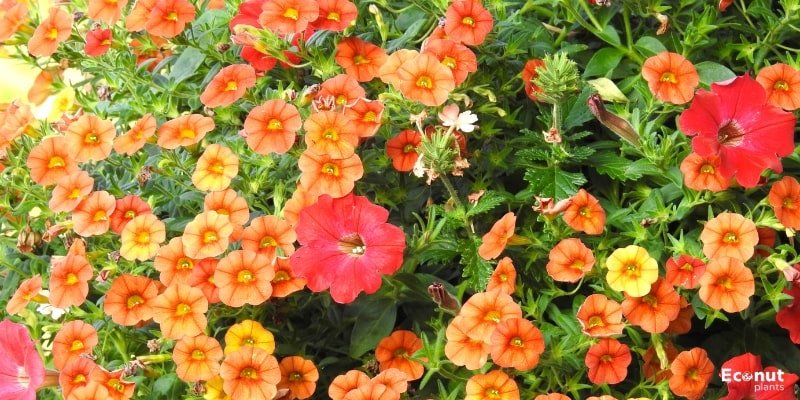
Scientific Name: Calibrachoa hybrid
Plant Type: annual
Plant Size: 6–12 inches tall, spread 12–24 inches wide
Sun Exposure: Full Sun
Tangerine Punch, like the other Superbells choices, works well in combination planters and hanging baskets as a spiller as well as filler. It has petals with a good deal of colour variation; the center of the flower is a deep, velvety black, while the petals’ outer borders are a gorgeous citrus orange. There is a striking contrast between the two hues.
Tangerine Punch combined with Colour Blaze Wicked Hot and Sweet Caroline Bewitched after Midnight would make the ideal Halloween container. Together, these three will produce a container with orange and black blooms and foliage.
3. Calendula

Scientific Name: Calendula officinalis
Plant Type: annual
Plant Size: 31 inches tall
Sun Exposure: Partial or full
A member of the daisy family, calendula is a potted version of the marigold. Depending on the species, it produces vivid orange blossoms with either a dark or orange interior. Calendulas should continuously flower throughout the year with the right growing conditions.
Calendulas grow in nearly any type of soil, so don’t worry if you weren’t born with a green thumb. For these plants to continue blooming, we advise deadheading them.
4. Buddleia
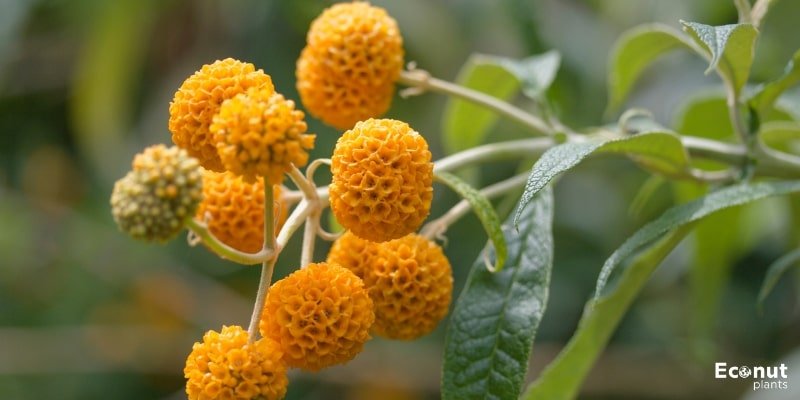
Scientific Name: Buddleja madagascariensis
Plant Type: Perennial
Plant Size: 13 inches high
Sun Exposure: Partial to full sun
Buddleia is a great choice if you’re seeking a fragrant orange-flowering plant. It blooms in the autumn and winter, with colours ranging from deep yellow to orange. The Buddelia’s blossoms are framed by lovely, deep green leaves.
Because buddleias are typically found growing on the 6,600-foot-high mountain slopes of Madagascar, they can endure greater altitude environments. They do, however, need warmer areas with constant temperatures above zero.
5. Frizzle Sizzle Orange Pansy
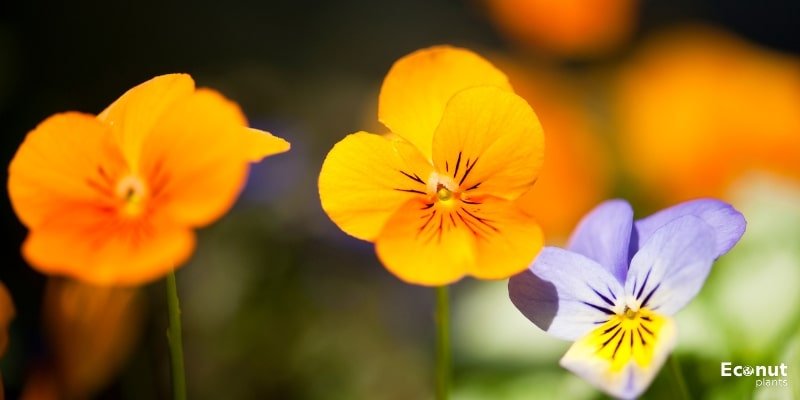
Scientific Name: Viola x wittrockiana
Plant Type: perennial
Plant Size: 8-10″
Sun Exposure: Full sun
Pansies are a popular garden flower because they bloom from mid-spring to early summer and come in a variety of colours. They are usually grown as annuals but can be short-lived perennials or biennials. In hotter climates as well, pansies make a popular fall floral arrangement.
The flowers appear rather flat and measure between two and four inches in diameter. To encourage additional flowering, remove the spent blooms.
6. Carnation
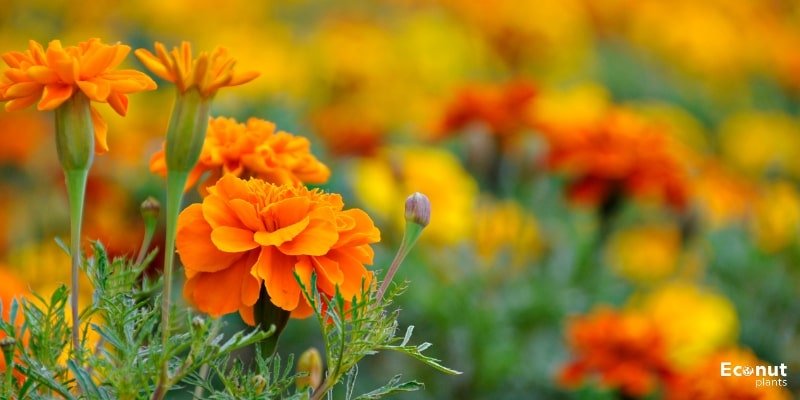
Scientific Name: Dianthus caryophyllus
Plant Type: perennial
Plant Size: 12 – 18 inches
Sun Exposure: Partial to full sun
Orange is just one of the many colours that carnations come in, which is one of the reasons why they are a popular flower among gardeners. Their blossoms can bloom up to five times in clusters or alone, with a maximum diameter of two inches.
The greenish-blue colour of the carnation’s leaves adds to their attractiveness. Neutral to slightly alkaline soil is suitable for growing carnations. Fun fact: They were once utilized for their scent in salad dressings, vinegar, beer, and wine.
7. Begonia
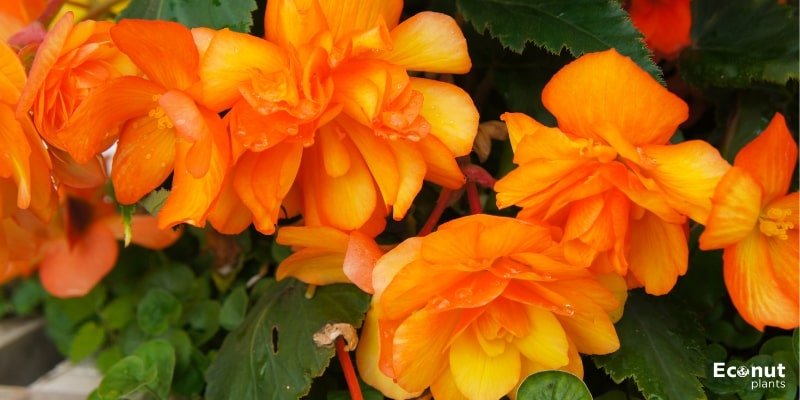
Scientific Name: Begonia obliqua
Plant Type: perennial
Plant Size: 6-24 inches tall
Sun Exposure: Full sun
These popular ornamental flowers do well in soils with good drainage and moderate sun exposure. Large, double blossoms in vivid orange, red, yellow, and pink hues are what they are most famous for.
Windy conditions are unsuitable for their survival. Picotee Sunburst, Encanto Orange, and Non-stop Orange are a few of its well-known orange varieties.
8. Celosia

Scientific Name: Celosia argentea
Plant Type: Annual
Plant Size: 4–6 in tall
Sun Exposure: Full sun
These heat-loving flowers have vivid orange, red, yellow, and pink hues and come in a variety of striking styles, such as feathery plumes and crested cockscombs. “Flamma Orange,” an All-America Selections winner recognized for its flaming orange plumes that resist fading and extended blooming season, is among the newest varieties.
9. Sneezeweed

Scientific Name: Helenium hoopesii
Plant Type: Perennial
Plant Size: 2 – 5 feet tall
Sun Exposure: Full sun
Sneezeweeds can be a bit of an eye trick because of their deep gold-yellow petals that turn downward and surround a dark orange centre that, like a honeycomb, sticks upward. For that reason, even though some people may consider this blossom yellow, we think its orange enough to make the list.
Large areas are best for planting sneezeweed since it creates stunning, vibrant borders and prairie coverings. This flower can also be cut and allowed to stand in a vase for a week or longer before the petals start to fall off.
10. Trumpet Vine

Scientific Name: Campsis radicans
Plant Type: Vine
Plant Size: 25 – 40 feet long
Sun Exposure: Partial to full sun
Massive 4–12 trumpet-shaped flowers per stem, fittingly dubbed trumpet vine, are produced by this plant. Only after the plant has spent a few months in warm weather do these deep-throated orange blossoms emerge.
Since trumpet vines grow quickly, make sure you have trellises installed and keep an eye on them to make sure the plant is growing in the desired direction. Regular trimming is necessary to keep these vines from taking over your yard because they can become invasive very rapidly.
11. Zinnia
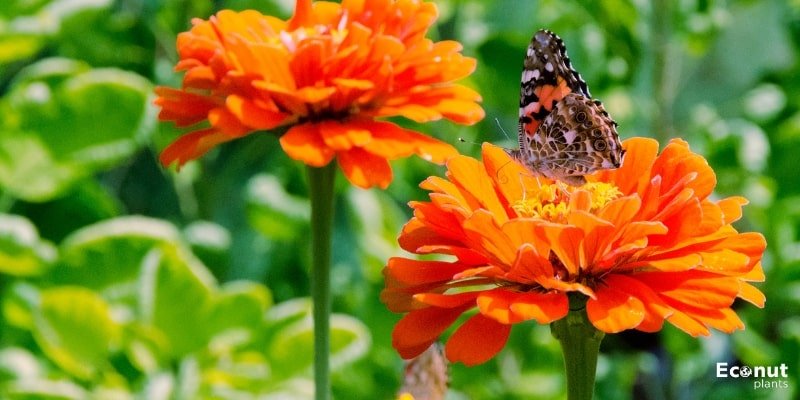
Scientific Name: Zinnia elegans
Plant Type: Annual or perennial
Plant Size: 1 – 4 feet tall
Sun Exposure: Full sun
Zinnias yield lovely, tiny flowers with tops that resemble daisies or pom-poms. When you visit a plant nursery, you should anticipate seeing a variety of orange hues because it appears that new colour variants of Zinnias are introduced to the market every year.
Zinnias are hardy plants that can tolerate nearly any sort of soil as long as it drains properly, so it’s difficult to go wrong when planting them. Most people don’t water zinnias as much because they tolerate a lot of dryness.
12. Red Hot Pokers

Scientific Name: Kniphofia uvaria
Plant Type: Perennial
Plant Size: 2 – 4 feet tall
Sun Exposure: Full sun
Red Hot Pokers is a true product, despite its tongue-in-cheek moniker. It resembles a blazing torch because of its five-foot-tall flower head, which radiates narrow, deep orange-red blossoms that face downward.
Thick clumps of red hot pokers are regarded as weeds in several regions of the world. On the other hand, you can enjoy their blooms, which bloom at different times during their growing season, if you purposefully put them in your yard.
13. Orange Bells
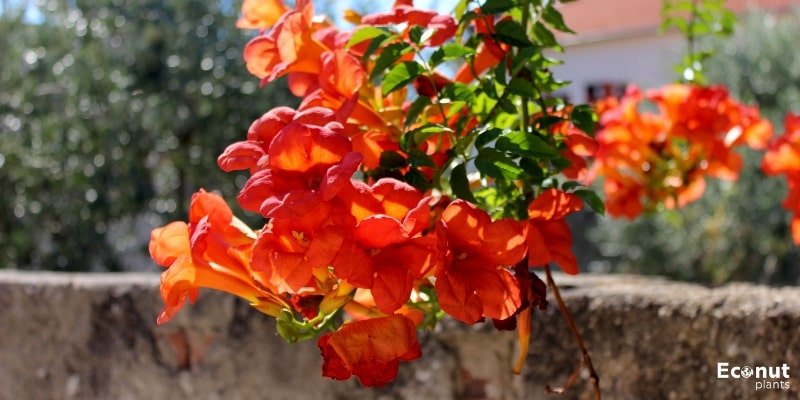
Scientific Name: Tecoma alata
Plant Type: Perennial
Plant Size: 10 – 15 feet tall
Sun Exposure: Partial to full sun
Orange bells are stunning trumpet-shaped blossoms that are difficult to top. They also come in orange, as their name suggests. Shrubs known as orange bells grow quickly in hot, humid regions. For shaping, we advise pruning them in the winter or autumn.
These plants provide vibrant, eye-catching borders for privacy. These bushes require little upkeep and do well in neutral or alkaline soil. We advise separating orange bells 6 to 12 feet apart due to their tremendous growth.
14. Mexican Sunflower
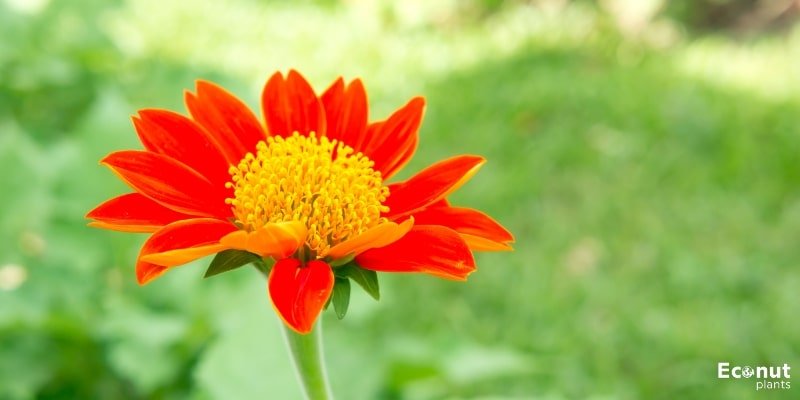
Scientific Name: Tithonia rotundifolia
Plant Type: Perennial
Plant Size: 3 – 8 feet tall
Sun Exposure: Full sun
Mexican sunflowers are distinguished from regular sunflowers by their deep orangish-red colour and absence of seeds. On the other hand, because the pollen on this tall plant comes from its dark yellow centre, it is a favourite of migrating monarchs.
Water must be readily available to the Mexican sunflower. Though it needs warm conditions to stay a perennial, it can grow at elevations above 3,000 feet. If not, you could be able to grow it as an annual in colder climates.
15. Lantana
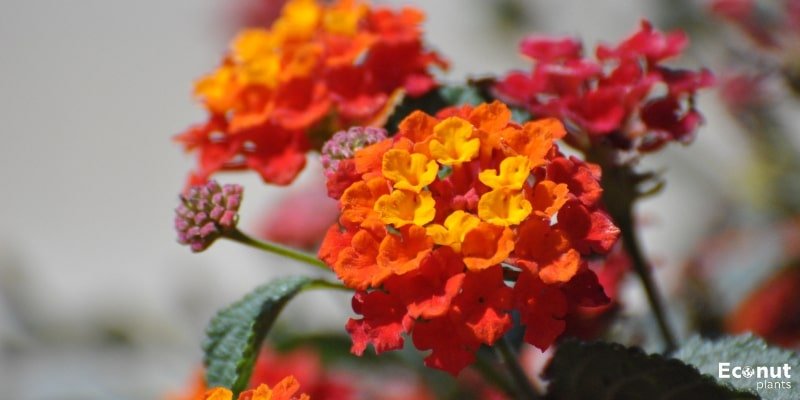
Scientific Name: Lantana camara
Plant Type: Perennial
Plant Size: 6 feet high
Sun Exposure: Full sun
Depending on its growing environment, lantana can be either a lovely addition to your landscape with its orange blossoms or a problem. This perennial grows quickly and bears many beautiful flowers that have alternating yellow and orange hues inside of them.
The fruit of the lantana plant resembles blueberries, but it is poisonous to people. If you do want to plant lantana, you’re in good shape because, within its USDA zone, it can thrive in a variety of settings and soil types.
16. Hummingbird Hyssop
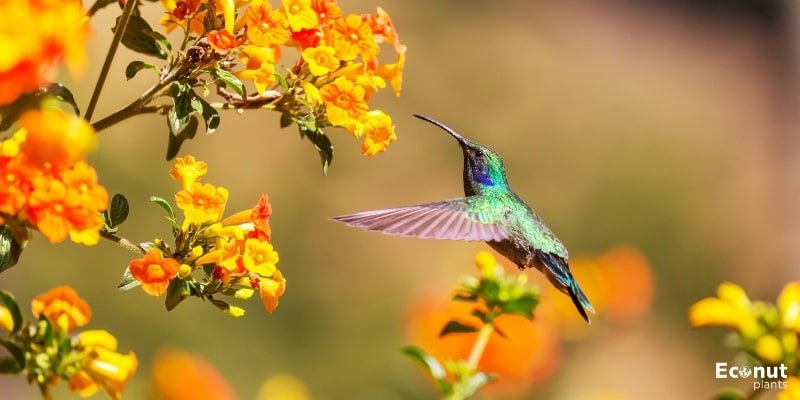
Scientific Name: Agastache
Plant Type: Perennial
Plant Size: 2 – 4 feet tall
Sun Exposure: Full sun
One of the various varieties of hyssop that has distinctive qualities is the hummingbird variety. This plant, which attracts hummingbirds, has fragrant mint leaves that you may crush up and smell. That should come as no surprise, considering that this plant is a member of the mint family.
Hummingbird hyssops require regular watering and soil that drains properly. Their upper section is covered in a variety of small blooms that grow on strong, high stalks. In addition to many other colours, orange flower varieties of Hummingbird Hyssops are available for purchase.
17. Gerbera Daisy
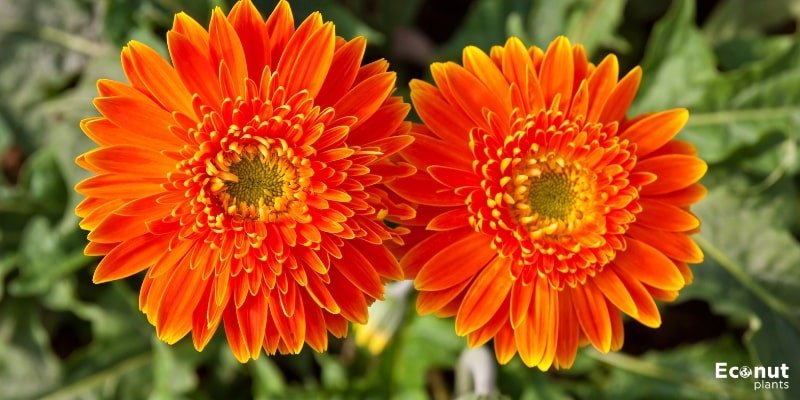
Scientific Name: Gerbera jamesonii
Plant Type: Perennial
Plant Size: 10 – 18 inches tall
Sun Exposure: Partial to full sun
The incredibly tiny petals of the Gerbera daisy spread out in a little upward curve from its centre, making it a special type of daisy. Orange-red is the most prevalent colour variant, and they flower from September to December.
In stony and sloping terrain, gerbera daisies thrive. Therefore, they require soil that drains properly. Due to their exceptional ability to disperse their seeds, you shouldn’t be shocked if, the following year, fresh daisies appear in different places.
18. Daylily

Scientific Name: Hemerocallis fulva
Plant Type: Perennial
Plant Size: 8 inches – 5 feet tall
Sun Exposure: Full sun
The reason daylilies only have one day of blooming is how they got their name. The good news is that this plant, which boasts orange blossoms from early summer to late autumn, produces a lot of flowers per stalk. The yellow centre and tiny yellow stripes on the petals of the daylily are ideal if you’re trying for a two-toned flower.
You can usually find daylilies by the side of the road and in fields. The leaves, petals, and tubers are edible. As a matter of fact, some people thicken soups with dried daylily blossoms.
19. Cymbidium Orchid
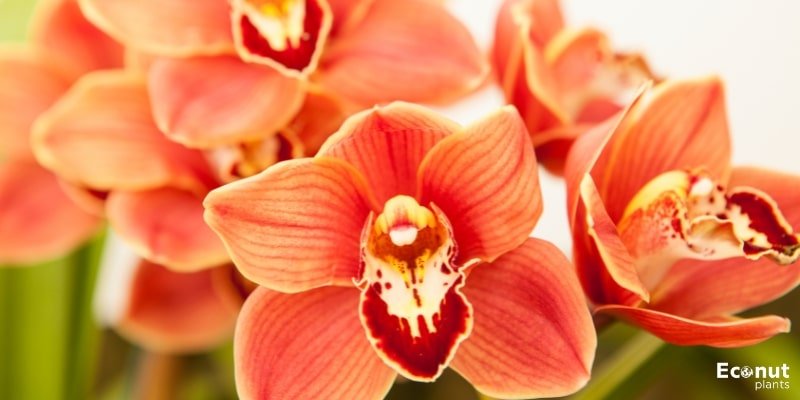
Scientific Name: Cymbidium
Plant Type: Perennial
Plant Size: 2 feet tall
Sun Exposure: Partial sun
The Cymbidium orchid may be the answer for you if you adore orchids but think you could never have one because you live in a cooler area. These orchids have spikes of flowers that endure for one to three months. They are available in a variety of colours, including orange.
You’ll like this plant’s tall, beautiful leaves even when they’re not in flower. In the event that you choose not to purchase a flowering plant, bear in mind that Cymbidium orchid seedlings require many years to reach their initial flowering stage.
20. Butterfly Weed
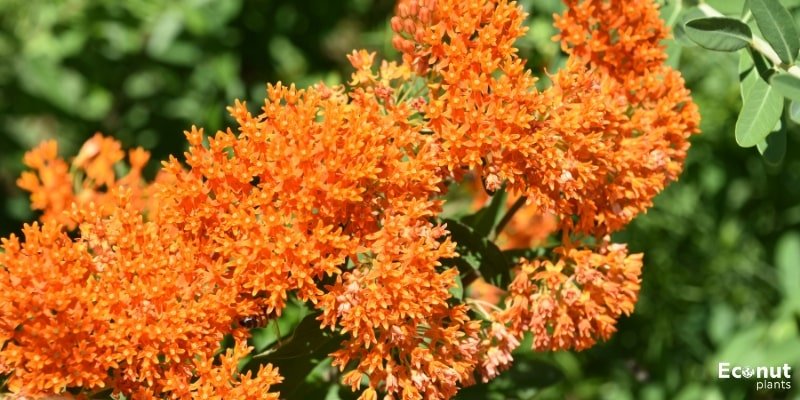
Scientific Name: Asclepias tuberosa
Plant Type: Perennial
Plant Size: 1 – 2 feet tall
Sun Exposure: Full sun
Butterfly weed is a popular plant to grow in gardens, so don’t be fooled by the word “weed” in its name. This is because a variety of butterflies are drawn to its vivid orange blooms. Tiny, yellow-centred flowers cluster together to form a single, flat-topped flower.
Although this plant is sometimes seen as an orange-flowered weed due to its invasive nature, many gardeners like the plant’s aesthetic qualities.
Chewing the root of Butterfly Weed helps alleviate pleurisy and other lung ailments, indicating that it also has therapeutic qualities. The plant requires a medium to moderate amount of water and flowers from May to September.
21. African Tulip Tree
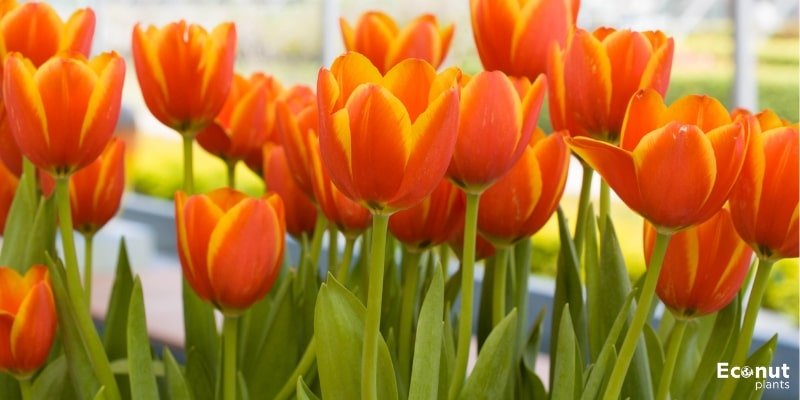
Scientific Name: Spathodea campanulata
Plant Type: Flowering tree
Plant Size: 23 – 82 feet tall
Sun Exposure: Partial to full sun
The striking reddish-orange blossoms of the African tulip tree make it an exquisite sight. Tell that to a botanist, though, as these trees are thought to be difficult to manage as invasive species in a number of regions worldwide. Nevertheless, because of their approximately six-inch-wide blossoms, many people want to use them as decorative trees.
Children especially like African tulip trees because they can play with their buds, which release water when crushed. But make sure your children are dressed in their trash. If not, the tree’s sap could leave behind yellow stains.
22. Bird of Paradise

Scientific Name: Strelitzia reginae
Plant Type: Perennial
Plant Size: 5 – 6 feet tall
Sun Exposure: Partial shade
The eye-catching Bird of Paradise will give you the impression that you are bringing the tropics into your house. Its sequence of orange, pointed petals that spread out at different angles and resemble a tropical bird gives it its name.
The Bird of Paradise flowers open one by one from their spathes. People in colder climates occasionally plant birds of paradise in their homes because they don’t do well in cold weather. From winter to the beginning of spring, you can admire its blossoms.
23. Canna Lily
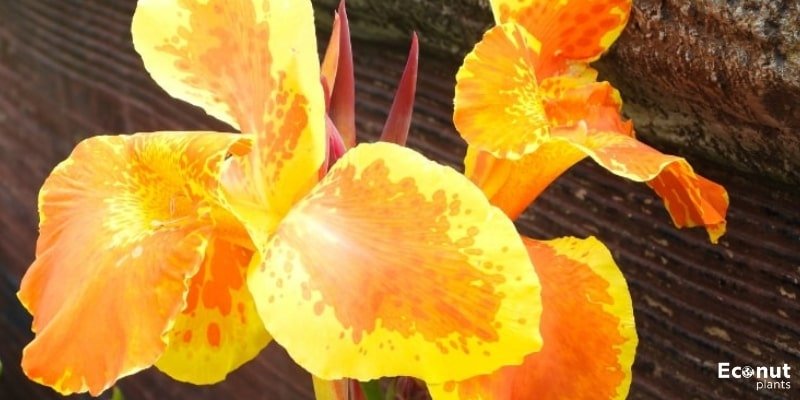
Scientific Name: Canna indica
Plant Type: Annual
Plant Size: 1.5 – 10 feet tall
Sun Exposure: Full sun
Tropical-looking plants also include canna lilies. Large, dark green foliage surrounds their enormous orange flowers, which resemble iris blossoms. It’s a great border plant because of how tall it grows.
Bogs and damp soil with good drainage are ideal growing conditions for these plants. Neutral or slightly acidic soil that is rich in nutrients is also preferred by canna lilies. They become perennials in warm regions, even though most people plant them as annuals.
24. Dahlia

Scientific Name: Dahlia pinnata
Plant Type: Perennial or annual
Plant Size: 1 – 6 feet tall
Sun Exposure: Full sun
The easy-to-grow Dahlia, which attracts butterflies, has upright stems with two to eight flower heads each. The flowers are medium-sized, ovate-shaped, and come in a variety of colours, including deep orange. From mid-summer to autumn, you can enjoy beautiful blossoms.
Dahlias were prized in the past for their therapeutic qualities, which included their ability to act as antibiotics. They prefer moist soil that is rich in organic matter, and their optimal pH range is 6.5 to 7.5. Light frosts are tolerable for these plants, but no more.
25. Frangipani
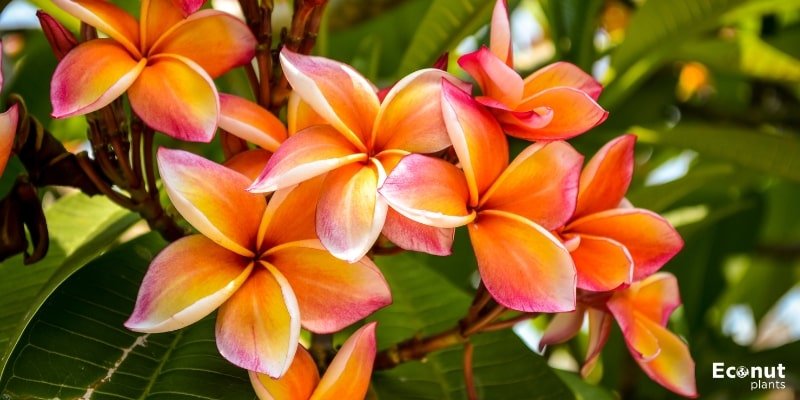
Scientific Name: Frangipani
Plant Type: Flowering tree
Plant Size: 20 – 25 feet tall
Sun Exposure: Partial or full sun
Frangipani provides the waxy, vividly coloured petals that people frequently wear in their hair when travelling to tropical climates. There will be a variety of orange Frangipani flower colours available, from pink with orange centres to more solid orange hues.
The best part is that frangipani trees continue to bloom from November through April. If your area is limited, you can ask plant nurseries if they have a dwarf variety of Frangipani that they could recommend.
26. Hibiscus
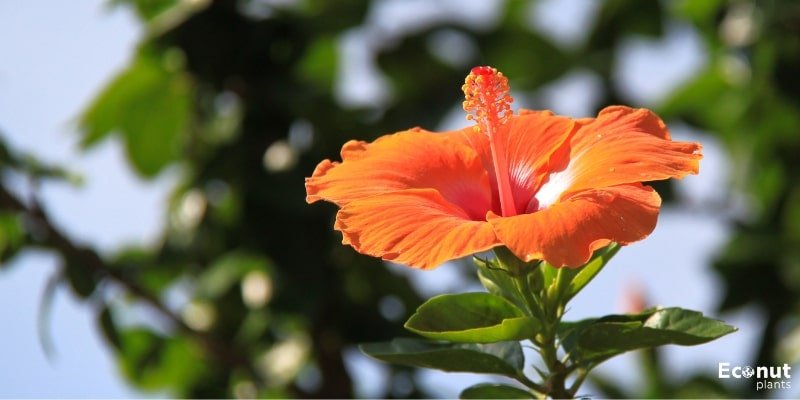
Scientific Name: Hibiscus rosa-sinensis
Plant Type: Evergreen shrub
Plant Size: 4 – 10 feet tall
Sun Exposure: Partial or full sun
Loved in tropical climates, hibiscus is prized for its huge, delicate blossoms as well as its high vitamin C content. For this reason, a lot of people use dried hibiscus flowers in desserts or drink hibiscus tea. Though hibiscus flowers are typically red, you may buy plants that bloom orange.
Hibiscus blossoms are available to you from summer through autumn. You can grow hibiscus in a pot if you live in a colder region; just bring it outside on warm, sunny days.
27. Iris
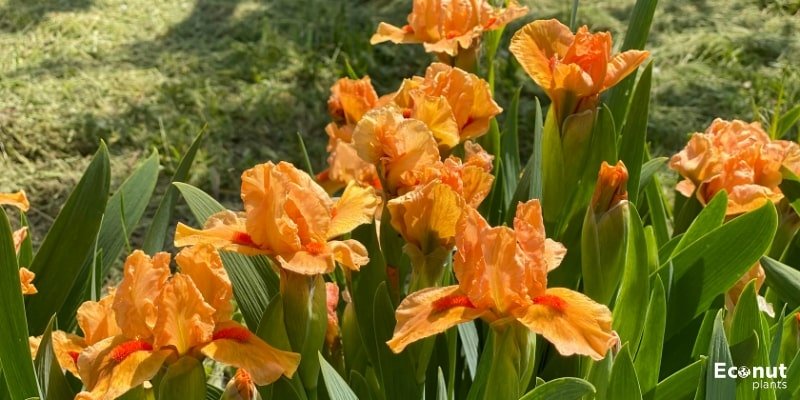
Scientific Name: Iris
Plant Type: Perennial
Plant Size: 12 – 40 inches tall
Sun Exposure: Full sun
The name iris comes from the Greek word “rainbow,” as it grows flowers with several colours. Thus, you should anticipate that the orange variety will have centres and veins that are yellow, brown, and white in colour. Six lobes on each bloom give them a beautiful appearance as they grow in different directions.
The iris is a resilient plant, despite its delicate appearance. As long as it has adequate drainage, you may grow it in practically any kind of soil. Certain iris species can bloom as early as February or March, given the correct growing environment and weather.
28. Marigold
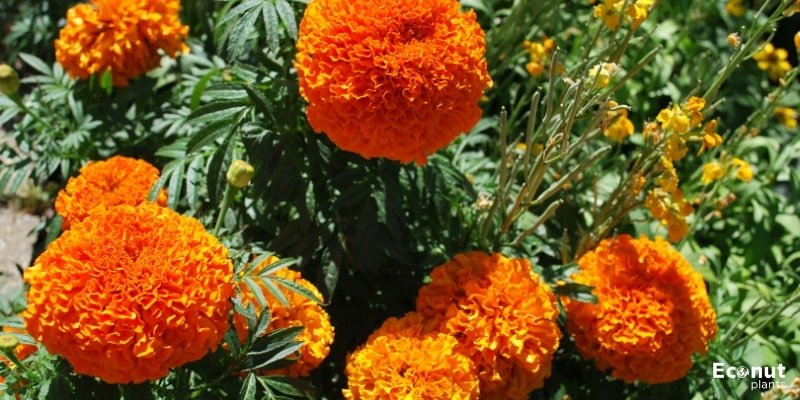
Scientific Name: Tagetes
Plant Type: Annual
Plant Size: 4 – 48 inches tall
Sun Exposure: Full sun
The classic Marigold, Tagetes, is a great plant to use in gardening. While marigolds occur in a wide range of colours, the most common ones are orange and a rich orange-like golden colour. These pom-pom-shaped blossoms help protect your plants from damaging insects.
Marigolds may be planted in practically any type of soil and are resistant to brief droughts. But when it rains, you should make sure they get enough water and have access to excellent drainage.
29. Nasturtium

Scientific Name: Tropaeolum Majus
Plant Type: Annual
Plant Size: 1 – 10 feet tall
Sun Exposure: Full sun
Hardy and gorgeous, tiny, orangish-yellow flowers are produced by the Nasturtium plant. They are a species that can be planted as ground cover, kept pruned as a bushy plant, or grown as climbers on a trellis.
The leaves of the Nasturtium resemble water lilies, and they go well with its May through September blooms. These quick growers like moderate amounts of water and can withstand dry soil, but not to the point of drought. They sprout quickly from seeds.
30. Persian Buttercup
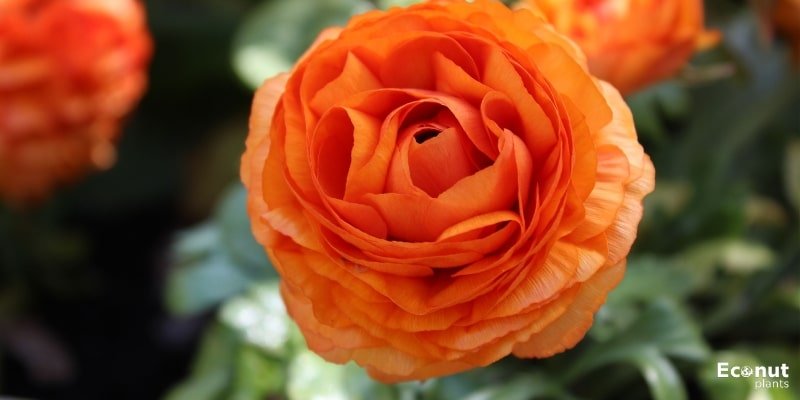
Scientific Name: Ranunculus asiaticus
Plant Type: Perennial
Plant Size: 1 – 2 feet tall
Sun Exposure: Full sun
Persian buttercups, commonly referred to as ranunculus, are exceptionally lovely in their own right. These plants bear tall, stem-borne flowers with dense, ruffled petals. In fact, their blossoms almost resemble a miniature, open rose when viewed directly down.
Persian buttercups come in a variety of hues, from pale orange to deep orange, which you can purchase. They need sandy or loamy soil, and they bloom in the late spring or early summer. Persian buttercups only require irrigation when the ground begins to dry out.
31. Verawood
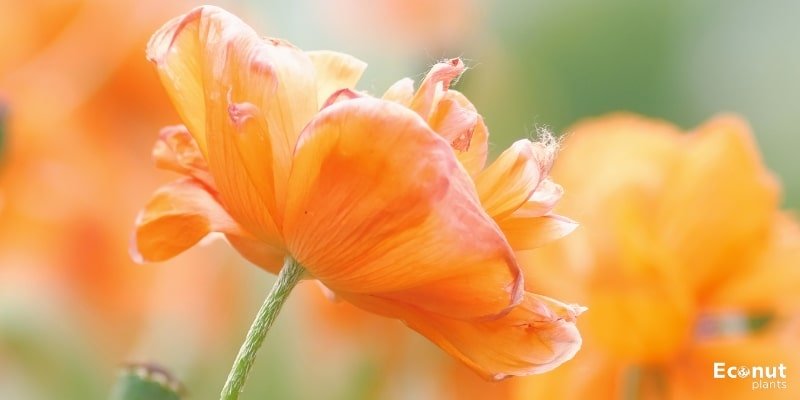
Scientific Name: Bulnesia arborea
Plant Type: Flowering tree
Plant Size: 49 feet tall
Sun Exposure: Full sun
In South America, the little Verawood tree is well-known for its hardy kindling. But because of its orange blossoms, this evergreen also makes a beautiful ornamental element in a planted yard.
Since verawoods grow well in practically any soil type, they need sandy, clay, or loamy soil; the pH of the soil is less important. Despite their preference for moist soil, these trees are not likely to be killed by severe winds or drought.
32. Stalked Bulbine
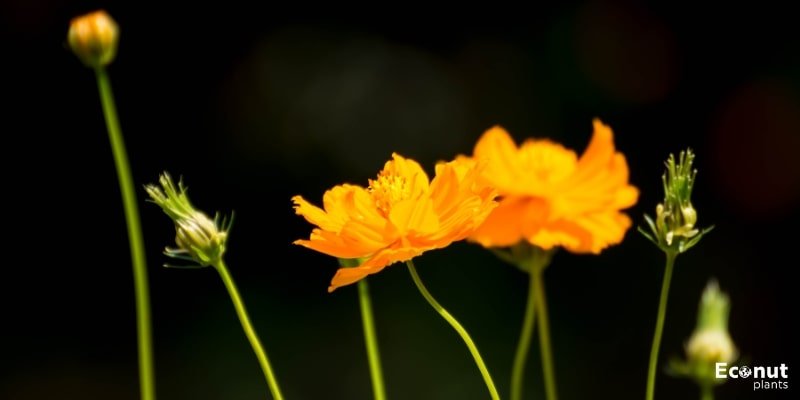
Scientific Name: Bulbine frutescens
Plant Type: Perennial
Plant Size: 1 – 1.5 feet
Sun Exposure: Full sun
If you’re searching for a blend of eye-catching shrubby greenery and vibrant orange flowers, the slim Stalked Bulbine is a perfect choice. The tiny blooms themselves are made more striking by the numerous ones that cluster on one stem and reveal their rich orange petals. Their stamens are likewise a lovely yellow colour.
You’ll be relieved to hear that the resilient Stalked Bulbine can tolerate anything from extremely humid conditions to dry weather if you’re afraid of harming plants. They work well for ground cover or rock gardens.
33. Spanish Gold
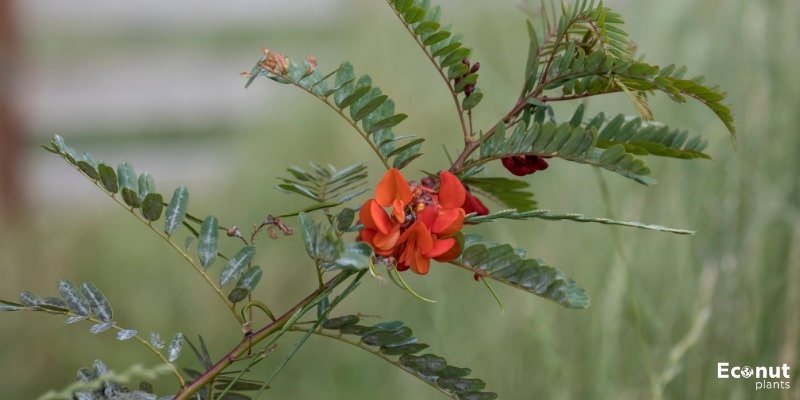
Scientific Name: Sesbania punicea
Plant Type: Perennial
Plant Size: 10 – 25 feet
Sun Exposure: Partial to full sun
The orangish-gold flowers that this shrub bears give it the name “Spanish Gold.” From June to September, you can admire its blossoms. Long, bean-like pods that are dependent on water for distribution emerge after the blooms fade.
Since Spanish gold grows naturally in swamps, marshy shorelines, and other damp places, you should plant it where there is plenty of water. It also needs soil that is quite acidic.
34. Pocketbook Plant
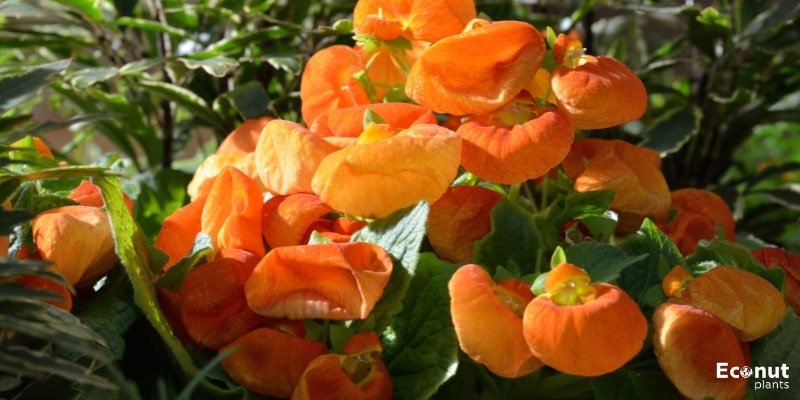
Scientific Name: Calceolaria crenatiflora
Plant Type: Perennial
Plant Size: 1 foot tall
Sun Exposure: Partial to full sunlight
We’ll let you decide whether or not the blossoms on a pocketbook plant resemble slippers more than a pocketbook, according to some. Whichever type you choose, the orange Pocketbook Plant with yellow highlights has flowers that are genuinely unlike any other on this list.
Cash plants are a common species to have indoors, though they can also be grown outside. To avoid root rot, they do best in soil that drains properly and has a moderate level of moisture.
35. Lion’s Tail
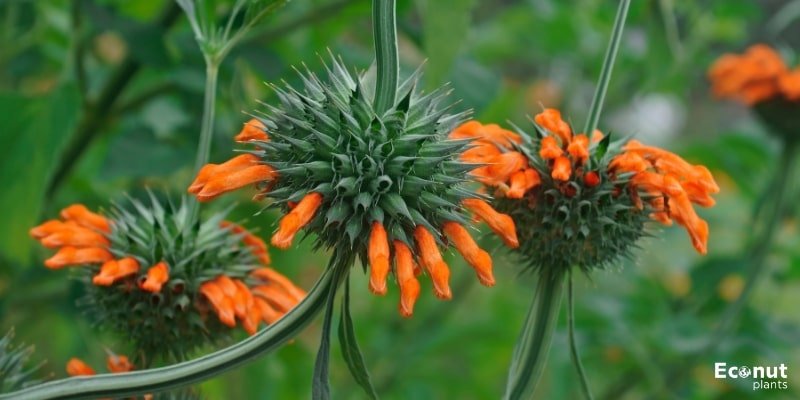
Scientific Name: Leonotis leonurus
Plant Type: Broadleaf shrub
Plant Size: 4 – 6 feet tall
Sun Exposure: Full sun
Another plant in the mint family with orange flowers is the lion’s tail. People take it as a medication to improve heart function, but it also contains a psychotropic ingredient. The tubular flowers of the Lion’s Tail are surrounded by many-tiered whorls on each stem.
If you reside in a warmer climate, you can enjoy Lion’s Tail blooms throughout the summer and even into the winter. Nevertheless, exercise caution when cultivating this plant, as it is prohibited in some nations, including Latvia and Poland.
36. Jamaican Rain Tree
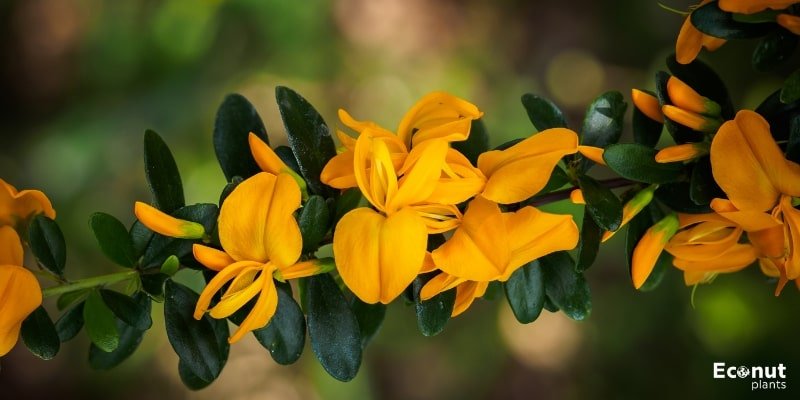
Scientific Name: Brya ebenus
Plant Type: Flowering tree
Plant Size: 20 – 30 feet tall
Sun Exposure: Full sun
The medium-sized Jamaican Rain Tree bears tiny, pea-like flowers. These flowers are classified as yellow by many, but we believe their rich, buttery colour makes them sufficiently orange to be included in our list.
The remarkable capacity of the Jamaican Rain Tree to tolerate drought may come as a surprise, given that it is native to a tropical climate. Its hardwood is still widely used in the production of musical instruments.
37. Impatiens
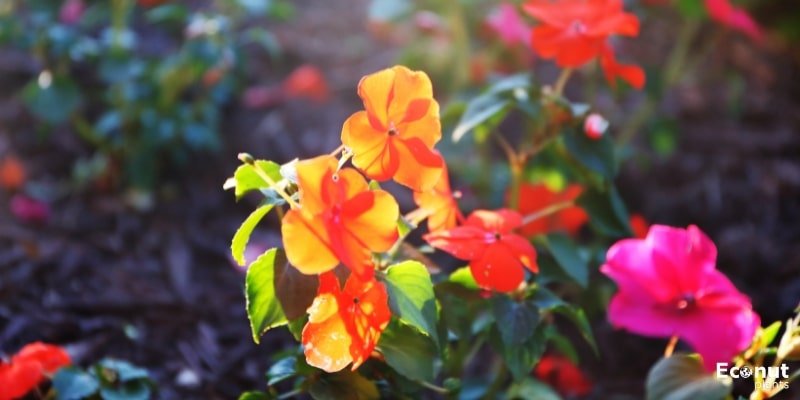
Scientific Name: Impatiens walleriana
Plant Type: Perennial or annual
Plant Size: 6 – 36 inches tall
Sun Exposure: Partial to full shade
A classic flower, impatiens come in a variety of colours, including different tones of orange. Its five-petalled blossoms can reach a diameter of about one inch. When in full bloom, the plant’s dark green leaves are mostly hidden by the abundance of blooms it bears.
As long as they have access to soil that is rich in nutrients, impatiens can be grown inside, in hanging baskets, and in flower beds. These plants become perennials if you grow them in warm climates or bring them inside for the winter.
38. Helenium

Scientific Name: Helenium
Plant Type: Perennial
Plant Size: 2 – 5 feet tall
Sun Exposure: Full sun
Helenium is a fantastic option if you’d like a variety of orange hues. The daisy-like plant is available in a variety of colours, from a traditional orange to an orange tinted with red, brown, and gold. You can usually get heliums that are a combination of some or all of these colours.
Low-lying meadows and other damp environments are ideal for helium growth. They also favour acidic soil; however, they can still live in clay. They also prefer well-draining soil. Rain gardens would benefit greatly from these plants.
39. Geiger Tree
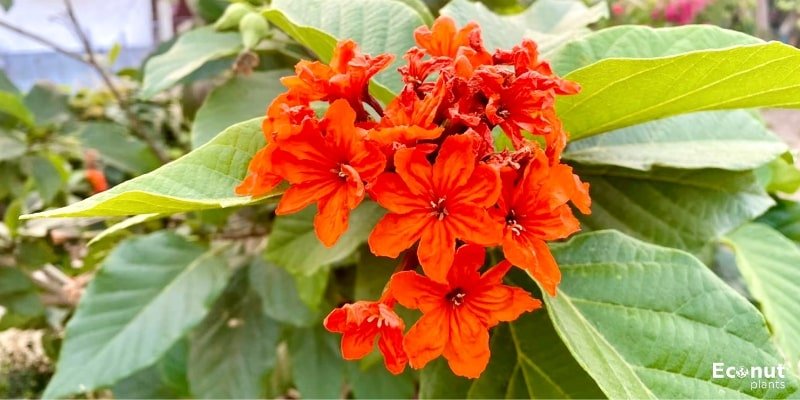
Scientific Name: Cordia sebestena
Plant Type: Flowering tree
Plant Size: 15 – 20 feet tall
Sun Exposure: Partial to full sun
Another orange-blooming tree with smaller natural growth is the Geiger, which many refer to as a shrubby tree. This tree bears dense clusters of bright orange flowers all year, but notably in the spring and summer.
Fruit that resembles pears appears when the petals fade. You’ll probably be tempted to consume one by their delicious aroma, and you can. They regrettably lack taste, though. Should you choose to plant a geiger tree in your yard, you should also buy a rake because these trees shed leaves that need to be cleaned up.
40. Flame of the Forest

Scientific Name: Butea monosperma
Plant Type: Flowering tree
Plant Size: 20 – 40 feet tall
Sun Exposure: Full sun
The Flame of the Forest is a great choice if you want a smaller, orange-blooming tree. When it blooms, the tiny, vivid, orangish-red flowers, which can reach a length of one inch, resemble a forest fire.
With three broad, glossy leaves on each stem, the Flame of the Forest’s leaves are as striking. Because of the tannin in its gum, leather craftsmen often use it. In addition, this tree is used by humans for colour, medicine, and wood.
41. Crocosmia
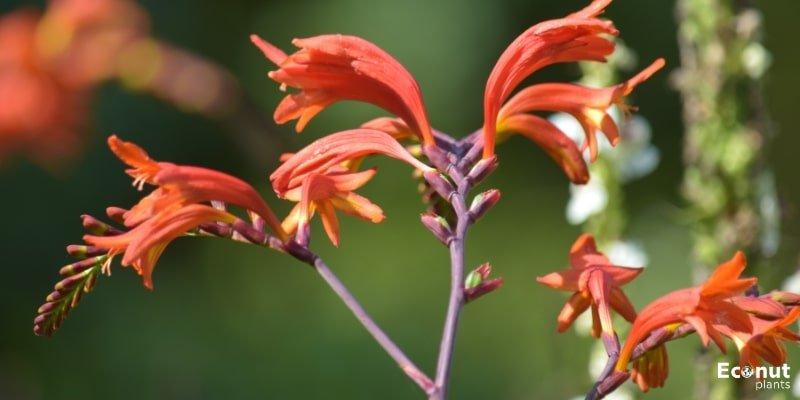
Scientific Name: Crocosmia
Plant Type: Perennial
Plant Size: 2 – 4 feet high
Sun Exposure: Full sun
Crocosmia is a member of the family Iris. You will therefore be able to appreciate enormous orange flower heads with five different petals each and lengthy stamens. The best part is that they bloom nonstop from early summer to late autumn.
In a moderate climate, your Crocosmia should be able to tolerate the cold. Additionally, it’s simple to propagate them—just remove the offsets in the spring and plant them anywhere you want additional orange Crocosmias.
42. Chinese lantern plant
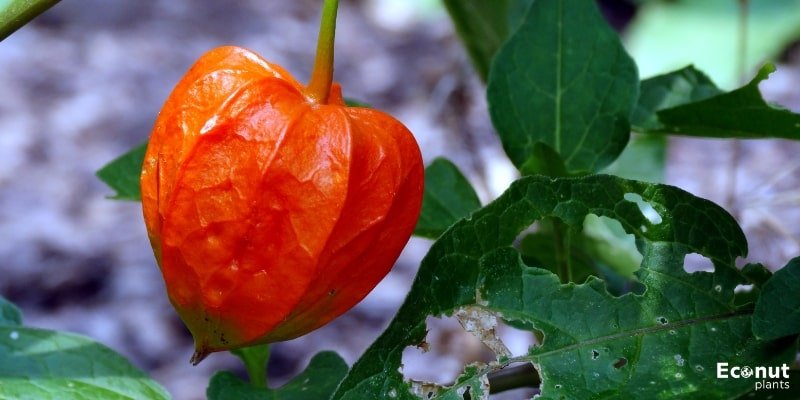
Scientific Name: Physalis alkekengi
Plant Type: Perennial
Plant Size: 1 – 2 feet tall
Sun Exposure: Partial to full sun
Since the Chinese lantern plant has white summertime blossoms, we’ll own up to our cheating here. But where the orange matters are its peculiarly formed, paper-like seed pods. You might enjoy viewing these vivid orange pods when late summer and early autumn arrive.
Because they spread quickly, Chinese lantern plants are best suited for potted cultivation. Their berries and seed pods may seem appetizing, but they are poisonous, so make sure your children stay away from them.
43. Lily

Scientific Name: Lilium bulbiferum var. croceum
Plant Type: Perennial
Plant Size: 3 – 4 feet tall
Sun Exposure: Partial or full sun
We are introducing you to another Lily. This time, the bloom is a real lily with a deep reddish-orange colour that tapers to brown at the stem attachment. This 2- to 3-inch-wide flower’s dark tips lend even more beauty to the contrast.
Unlike many other species, which have petals that droop, the Lilium bulbiferum Lily variety’s petals face primarily upwards. As long as you give it enough water, it can withstand most soil types and bloom in the early summer.
44. Million Bells
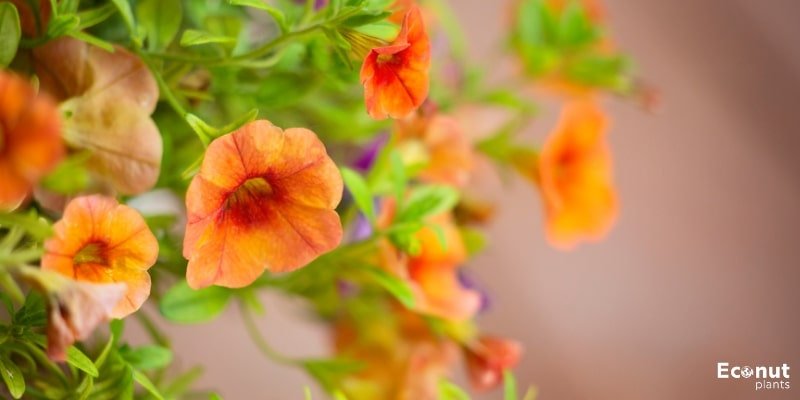
Scientific Name: Calibrachoa
Plant Type: Perennial or annual
Plant Size: 6 – 12 inches tall
Sun Exposure: Partial to full sun
If you want to add orange colour to your landscape, Million Bells is a great plant with orange blossoms. The flowers are bell-shaped, kind of like petunias, with darker orange-to-red circles and veins surrounding the centres.
The most remarkable of all is that, in the correct circumstances, Million Bells bloom for nine months of the year. They can barely withstand more than a light frost; therefore, it’s important to keep them out of the cold.
45. Pansy
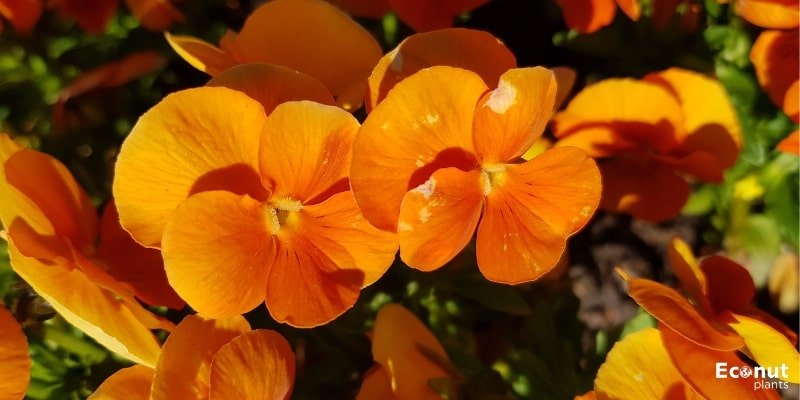
Scientific Name: Viola tricolor var. hortensis
Plant Type: Perennial, annual
Plant Size: 4 – 8 inches tall
Sun Exposure: Partial or full sun
A favourite among gardeners are the heart-shaped petals of pansies. Pure orange hues are rare among these blooms. Instead, anticipate seeing people wearing bright designs in shades of brown, yellow, and orange, to mention a few.
Flowering quickly, pansies shrink in intense heat and don’t mind being colder. As biennials, they can be grown if you plant them in regions with moderate winters. Give your pansies soil that drains properly and has a hint of acidity.

